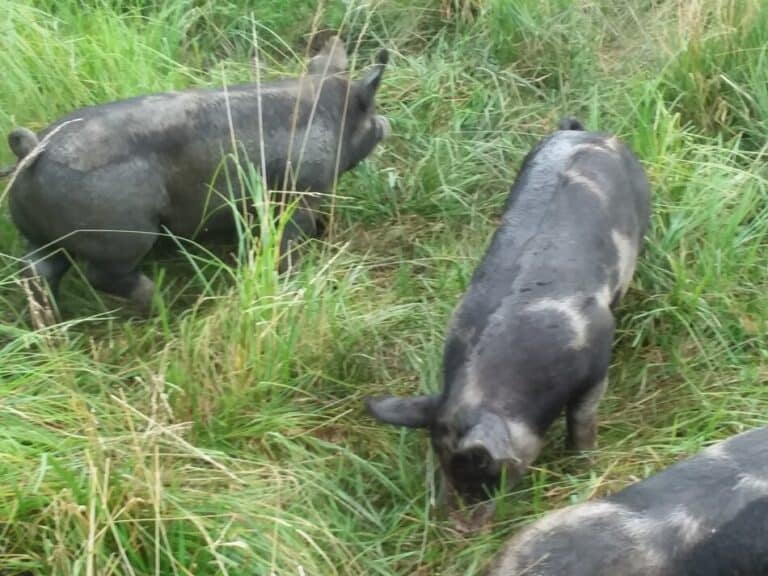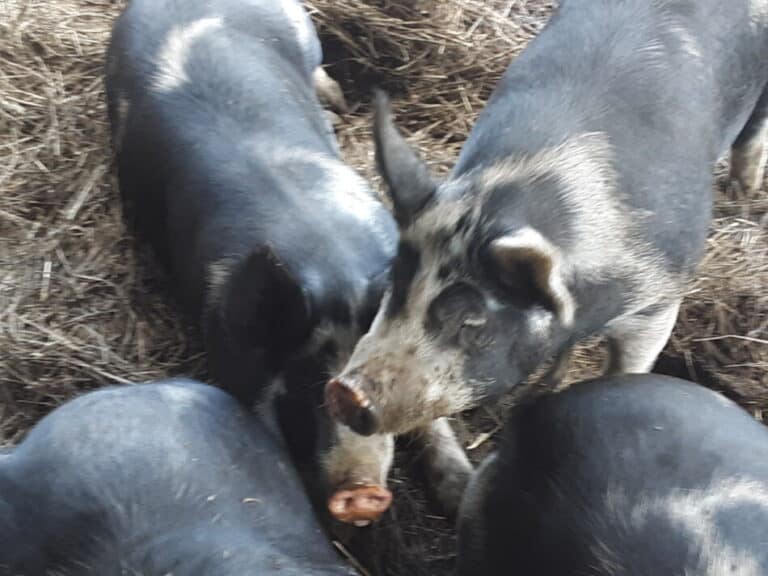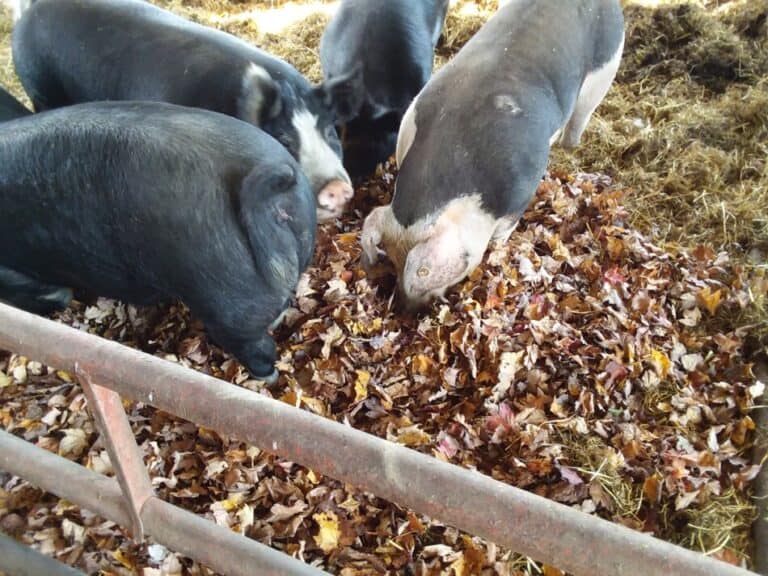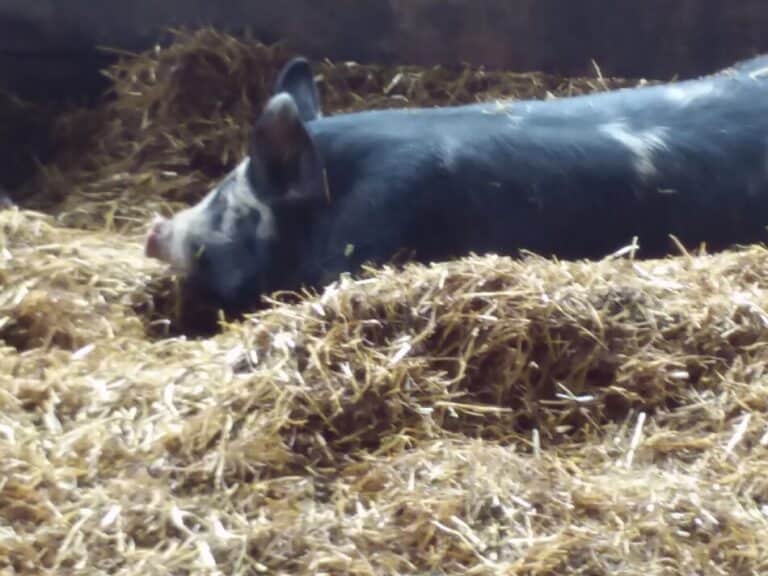Pig Reproduction: Beginner Basics

Thinking of getting into raising your own piglets, but not sure of where to start? Let me help you with the basics.
Breeding age pigs are called boar (male), sow (female that has given birth) and gilt (female that has not given birth). Farrowing (birth) happens 114 days after breeding.
Raising your own piglets is a big step up!
Maybe you’ve raised a few groups of feeder pigs and decided that you are a pig person after all?
Or, like me, you looked into the economics of buying feeders versus raising your own and said “I should look into this baby pig thing.”
Let’s look into the terms you need to know so you can get started with pigs as well!
Read is Raising Pigs For Meat Worth It for a look at the costs involved in raising pigs.
There are basic terms for pigs
Before we get into too much detail here, we need to define some terms that will be used throughout the rest of this article.
- Gilt-female pig that has not had any piglets yet, she can be of any age
- Sow-female pig that has given birth at least once
- Boar-male pig that is not castrated, he can be of any age
- Farrowing-pigs giving birth
- Gestation-pregnancy
- Sexual maturity-the pig being physically able to reproduce
- Breeding stock-pigs keep for breeding purposes
- Litter-group of piglets born at the same time to the same mom
- Terminal cross-breeding two different breed parents to produce a pig that will be sold for meat
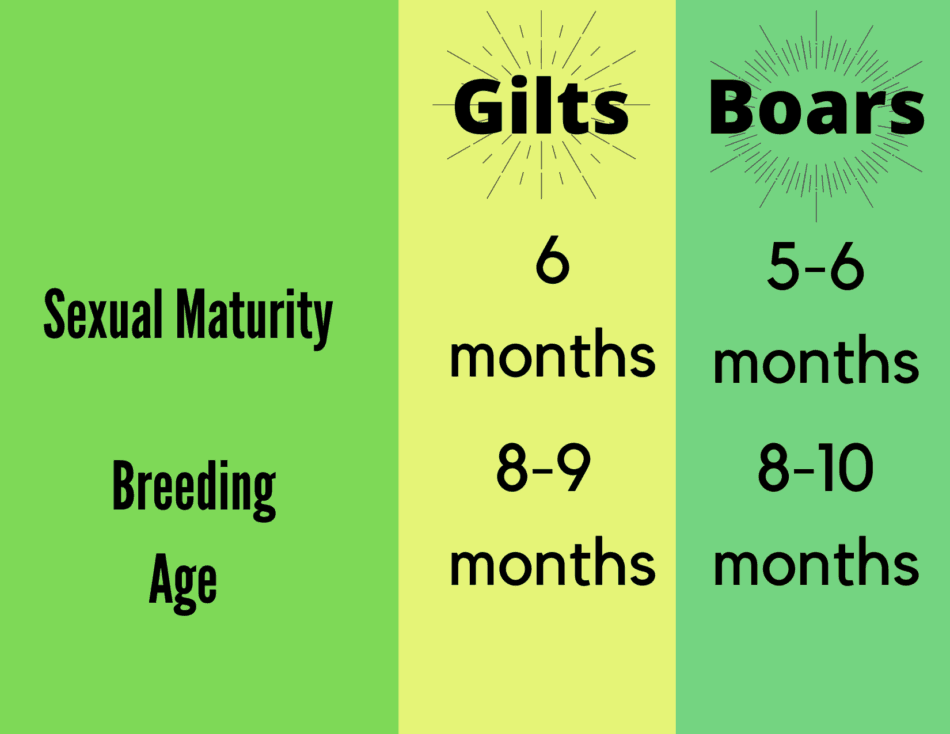
Gilts reach sexual maturity at 6 months
Gilts will reach sexual maturity in about 6 months. While a gilt this young could be bred now, it is best to give her some time to grow a bit bigger.
Most producers will keep them separate from the boar until the gilts are closer to 8-9 months of age.
Remember, once she is bred part of her energy goes to the developing babies, so you want her to be at a good body size before breeding.
Notice the keep the gilts separate from the boar part. If you house them all together they will breed as soon as the females start to come into heat.
That doesn’t mean she is big enough to be bred, or that the litter will be born at a time of the year that you want, just that keeping them together will get her bred early.
If that is not what you want, the gilts and boars must be housed separately once the gilt reaches 100 pounds or so, small breeds sooner.
At 100 pounds she will not be coming into heat yet, assuming she is a large breed pig.
A boar sexually mature at 5-6 months
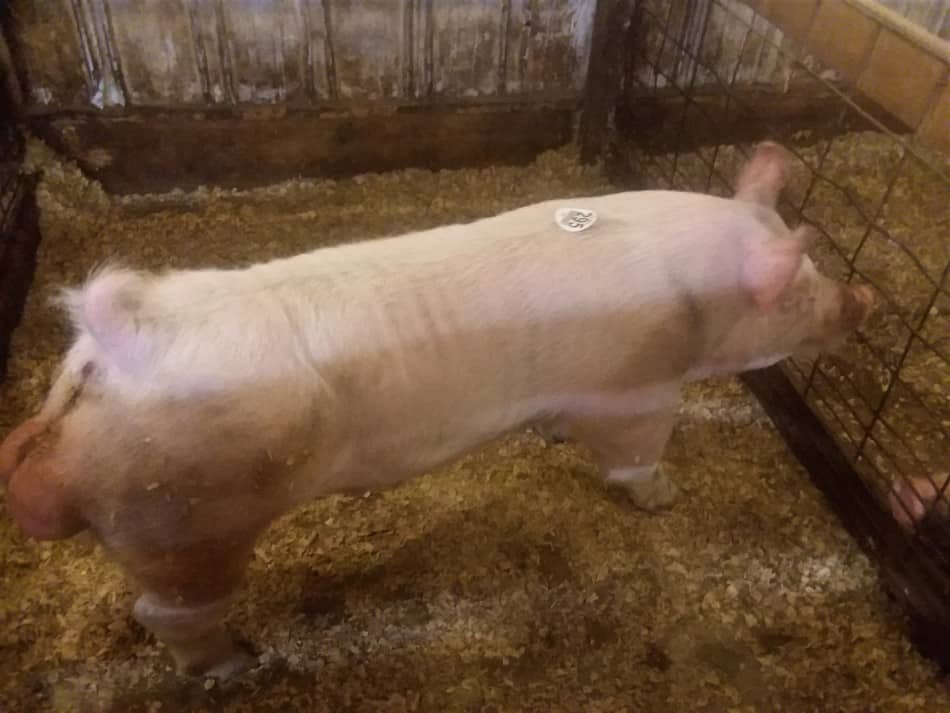
At between 5-6 months of age, your boar will hit sexual maturity.
A boar purchased this young will need to grow a few months before you can reliably use him.
The bigger deal with a younger boar than age is size, he has to be big enough to breed the females.
Gilts his age will be fine, but sometimes a few of the bigger sows will be too pushy for a new, more timid boar.
You will want to purchase a boar that is a bit older, closer to 8-10 months old. This way he is big enough to breed the taller sows yet still light enough to be able to breed gilts.
Nothing wrong with an older boar, as far as genetics go. It’s his size, he can be too heavy for younger or smaller females.
Plus once you have a few litters growing, should you decide to keep some gilts like I did, you need a different boar anyway. That is why I sold Toby, my first boar, I’m keeping some of his daughters.
Breeding stock pigs do not have to be the same age
The male and female pigs to be bred together do not have to be the same age. Actually it is pretty common for the sows to be older than the boar.
It is normal keep a sow for a few years, but get a new boar much more frequently, which would mean the females are generally older than the boar.
The exception to this mismatch in age is when the female is a gilt. Gilts are normally bred to a boar close to the same age as she is.
Why? Simply because she is a bit smaller than the other sows, she hasn’t finished growing yet, she needs to be bred to a smaller (younger) boar.
Of course, all of this age and size difference stuff goes out the window in the case of Artificial Insemination (A.I.)
Since the semen is shipped to the farm, the size of the boar is irrelevant because the breeding pair never actually come face to face.
We have always used a boar, but A.I. is becoming very popular, especially with show pigs.
If you are considering A.I. look it up online. There are quite a few places that offer pig semen and will handle the shipping.
Be sure you do your research, since pig semen has to be shipped fresh and used right away.
Since I had written this article, we have done A.I.! Here’s a video about the costs. For a summary, it went well and we got two nice litters out of this order of semen.
Pigs can reproduce for years
There isn’t a specific number of litters a sow can have before she starts to slide in productivity.
As usual with livestock, this will depend upon the individual sow and the management of the sow.
Commercial hog farms will have a schedule for the sows that includes culling (selling) them after a specific number of litters, anywhere from 4-6 litters, which is 2-3 years.
The culling plan will be tailored to the line of hogs they are working with and implemented with the purpose of keeping the most productive sows in the system.
For a smaller producer, the strict culling schedule is not needed, but could be used if you choose.
Most small farmers would just monitor the productivity of the sow or just sell her, due to limited barn space, when you have a better one to replace her with.
A gilt will have her first litter when she is a year old and, if all goes well, have two litters a year after that.
She can keep having piglets until she gets too old to be a reliable breeder or can no longer care for her babies.
Most sows should be able to stay productive for three years but there is no reason that your sow couldn’t stick around for five or more.
This all depends upon her. Most people will notice that when a sows starts to produce less piglets she is getting to old to stay and must be sold.
Pigs have 8-12 piglets per litter
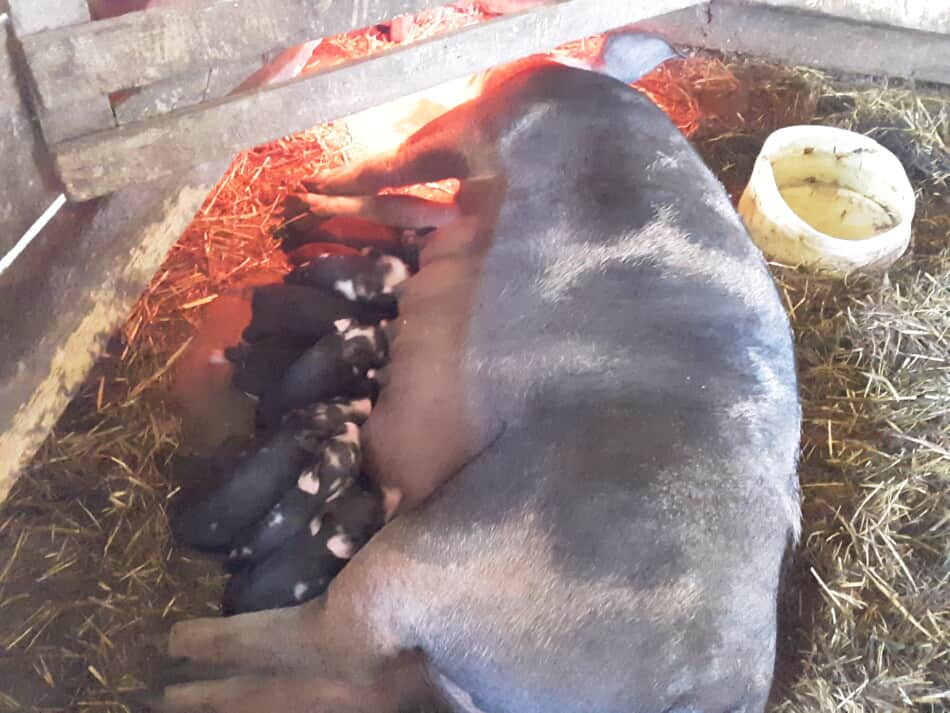
A good average to think of is 8-12 piglets per litter. We have had sows farrow as many as 18 and as few as 4.
Generally speaking, maternal breed sows (think long white pigs like Yorkshire) will average more pigs born per litter than meat breeds.
Number of piglets per litter will depend upon the genetics of the sow and the care of the sow before and during pregnancy.
If you buy your breeding stock from a farmer and want to know the specifics, ask. Farmers keep back for breeding stock the best of their animals, he’s got some numbers to share.
Commercial hog farms are wanting to average higher than 8-12 pigs per litter, they are shooting for an average of more like 13-14.
Logical question (from you!): Why would anyone be happy with less piglets per litter? Shouldn’t every one with pigs choose the highest producing sows possible?
Of course, I want more piglets per litter and I do select for the pigs that do the best for me, including raising more piglets.
Chances are that pigs in our system will not farrow as many piglets as the sows in a commercial system.
I would love more piglets per litter, but to get the commercial hog producer’s average pigs per litter number isn’t likely.
Why? First off genetic differences, they have maternal line sows and I have more of a meat breed sow. Right there is a difference of 2-4 pigs per litter.
The other factor is that I want the resulting feeder pigs to be of a chunkier build, that just sells better around here.
Generally chunky build equals a lower number of piglets per litter.
Pigs can have 2 pregnancies per year
Most farmers would want their sows to have two litters of pigs per year.
The gestation is roughly four months and raising the piglets up to weaning takes another 2 months, for a total of six months.
The breeding cycle will repeat again for the next half of the year.
Some farmers would choose to keep their sows at one litter per year, to avoid severe weather, especially with an outdoor system, or for date/time of year specific litters, like fair pigs.
Pros And Cons Of Raising Pigs goes over the good and not so good aspects of raising pigs.
Pig’s gestation period is 114
A sow’s gestation period is 114 days. The easy way to remember this is to use the saying 3 months, 3 weeks, 3 days.
Obviously, if you want the exacts you’ll need to calculate the 114 days. We always use the 3’s saying, since it is quick and easy.
Don’t get too hung up on the exact due date for the farrowing. Just like anything else in nature, exact dates for birth are a guess and depend greatly upon the individual.
114 days is a good average to use, but a few days sooner or later would be completely normal.
This means at about a week before her due date, you should move the sow into her farrowing area. This gives her time to adjust and arrange the area to her liking.
Do pigs mate for life?
Pigs do not mate for life. Generally, anything that can be raised on a commercial farm does not mate for life.
Since keeping all of those males around would drastically increase barn space or pasture space needed and send the feed costs through the roof, farmers tend to keep livestock that can use one male for many females.
Pigs work more like deer in terms of breeding males.
With deer the biggest, most fit buck keeps all of the other males away from his females. Wild hogs would do the same thing.
Breeding pigs from the same litter has risks
Breeding pigs that are closely related is a practice called inbreeding.
However, the real question is what are the consequences from doing so? Can You Breed Related Pigs? goes more into inbreeding and linebreeding if you want to dive in deeper.
The first answer to the results of inbreeding: possibly nothing unusual. It could be the resulting pigs will be just fine.
The second answer: baby pigs that are poor doers and will be a disappointment to raise.
The catch here is that you do not know the results until you try the breeding and see what the resulting pigs are like.
The concern with inbreeding is that it concentrates the genetics of the two already closely related parents.
The positive side of inbreeding is that it concentrates a trait that you want to keep, since you would be getting more of that trait from each parent than from a normal breeding.
These concentrated traits can also show up negatively. This means that any detrimental genes that would have been diluted in breeding unrelated pigs will now instead be concentrated and start to show up.
The negative effects of inbreeding are well known and can happen in all animals that would normally have a wide genetic pool.
Meaning the negative effects of inbreeding can show up in livestock as well as pets, like dogs.
Breeding stock pigs are commonly outcrossed
Most pig breeders would seek to do the opposite of inbreeding, which is outcrossing or hybridization.
Best Pigs For Breeding Stock gives you some insight into which pigs to choose for your breeding herd and why.
Outcrossing for purbred pigs
Outcrossing means you are using genetics that are from different family lines as your current genetics, while still being part of the same breed.
If you are raising Yorkshires, you want the boar to be completely unrelated to your sows, in order to produce healthy, well grown pigs.
But it also must still be a Yorkshire (if you are keeping purebred stock).
Hybridization is popular for market hogs
Hybridization means creating a hybrid, which is a mix of two separate breeds.
In pigs, a very common hybrid is a white maternal line female bred to a meat breed male, like a Hampshire or Duroc. The piglets would be a hybrid, more commonly known as a cross bred.
These pigs would be a terminal cross, since they are bred to be market hogs.
The blue butt pigs I purchased would be from this type of a cross breeding system, most likely Yorkshire mom and Hampshire dad for the blue specks.
To get more hybrids you have to rebreed the original parents. Keeping the hybrid for breeding is moving into mixed breed territory.
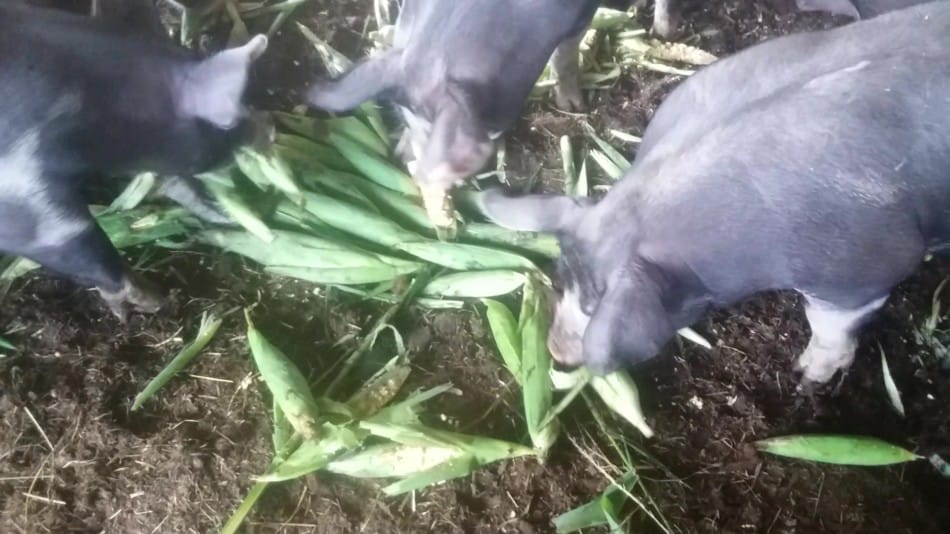
Hybrids are different from mixed breeds, in that the hybrid is an F1 cross of two different breed parents, creating a very specific baby.
Mixed breed means the different breeds or mixes of breeds are added in as the farmer feels needed.
Get breeding age pigs from a farm
You can raise your own from feeder pigs, you can get them at a breeding stock auction, or you can get them from a farm.
If you are completely new to livestock, it’s best that you go to the farmer, talk over what you are looking for and have him or her pick breeding stock that will suit you.
Nothing wrong with getting pigs at the auction, I did. But, you are taking a chance of not getting what you are wanting or needing, since you don’t know where they came from and how they were treated.
The sure bet is to purchase breeding stock from a farmer. You’ll pay a bit more, but you’ll also be getting something that is worth more, so it is worth the price.
If you are completely new to pigs, please get your first breeding stock from a person, not an auction or a sale. It will save you stress and get you headed toward success more quickly.
Best breed of pig to get for breeding stock
I have to say this section heading is a bit of a teaser. There if no ‘best breed.” Sure, people have their opinions, sometimes strong ones.
Most folks think whatever they currently have is best, and hopefully it is, for them. For you? Maybe, maybe not.
People get too hung up on breed when just starting out. You want good pigs that will suit you and your situation.
Get something you like that will do what you need it to do. Choose based on conformation and attitude, first.
That’s why I went with Berkshire, they seemed to be the best fit for me.
Please, for your own sake, place a heavy premium on good attitude.
Pigs are big, fast and strong. No need to have mean in the mix, it’s not safe. Seriously, a mean pig has to go.
A little story: We are taking care of a friend’s sow right now, she was bred to my boar and farrowed here. I was glad to have her.
Then we went to castrate the boars at three days and she turned into monster, really.
If she gets out of her pen, we have to sneak around and stay out of sight or she will come after us. She’s scary and it came out of nowhere.
Mean pigs need to be culled.
Selecting Breeding Stock For Heritage Hogs is a great overview article for selecting breeding pigs. Don’t get hung up on the title, these are great selection criteria for pigs no matter what breed you are working with.
Summary
Choose to start off with high quality breeding stock. Paying a bit more at the start will repay you over and over with ease of managing your pigs and well grown feeders or market hogs to sell.
So often, cheap or “that’s a deal” livestock end up being more costly to raise, they are poor doers and will suck down the feed for little resulting growth.
Get some feeder pigs first and see how you like having pigs around.
When you are ready to get into buying your own breeding stock, start with good genetics, you’ll be glad you did.
My current pig breeding stock story
This is exactly where we are at with our pigs now. I wanted to do more with pigs, instead of buying in groups of feeder pigs.
We have raised pigs on and off for years, sometimes sows, sometimes just a few feeders, but generally something, if for nothing else than for the freezer.
Three years ago I felt I needed to get back into “the pig business” for myself. (Previously, pigs had always been more of my husband’s project than mine.)
The first pigs I bought were these four super small Hampshires.
Really, they were quite young to be put through an auction, and feeder pig prices were high at the time so I got these little white striped black pigs because they were more affordable.
I texted my husband that I bought some and when I pulled in at the farm, he looked at the truck and said “Where are they?”
They were so short you couldn’t see any of them over the sides of the truck!
They took a bit longer than most to grow, since they started out so small, but they did well and the one we ate tasted great.
So I decided to up my game and get a few more the next time.
I bought a group of blue butt (standard commercial cross bred pigs with white body and grey specked butt) feeder pigs.
We sold most as market hogs, ate one and kept some back that I felt had breeding stock potential.
I have one of the gilts I kept back out of that group as my current sow, Whitney.
Last year I bought a Berkshire boar I named Toby, the sire of this year’s piglets.
Whitney’s first litter was 10 piglets out of which I have kept back the three gilts. The gilts are now about to breeding age, another month to go.
I purchased a Berkshire boar yesterday that I call Wilson (he’s the black boar pictured above). He will be put with the gilts for piglets in the spring.
I’m sure you’re wondering, why Berkshire? Personal choice, in general, but there are also specific reasons.
Berkshires have a great reputation for flavorful meat, good attitude on the part of the boars, and a nice meaty, fast growing market hog.
They are also a great feeder pig should I decide to sell them at 50-60 pounds, instead of feed them out to market size.
In our area, feeder pigs that are chunky are bringing a much higher price than ones that are thinner built, $35-40 vs $55-60.
Since I’m buying a boar either way, it just makes the most sense to choose the boar that is likely to produce the higher value feeders.
That’s how I got going with breeding pigs and the current state of what we’ve got around here, pig wise.

